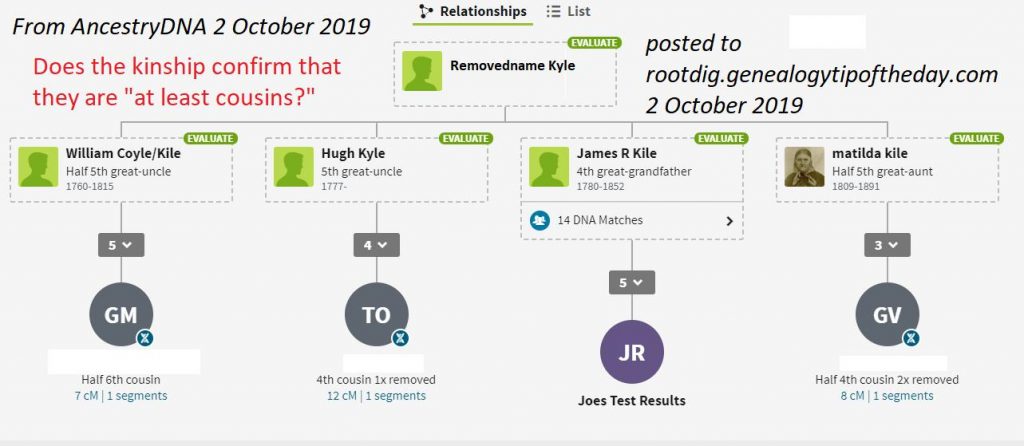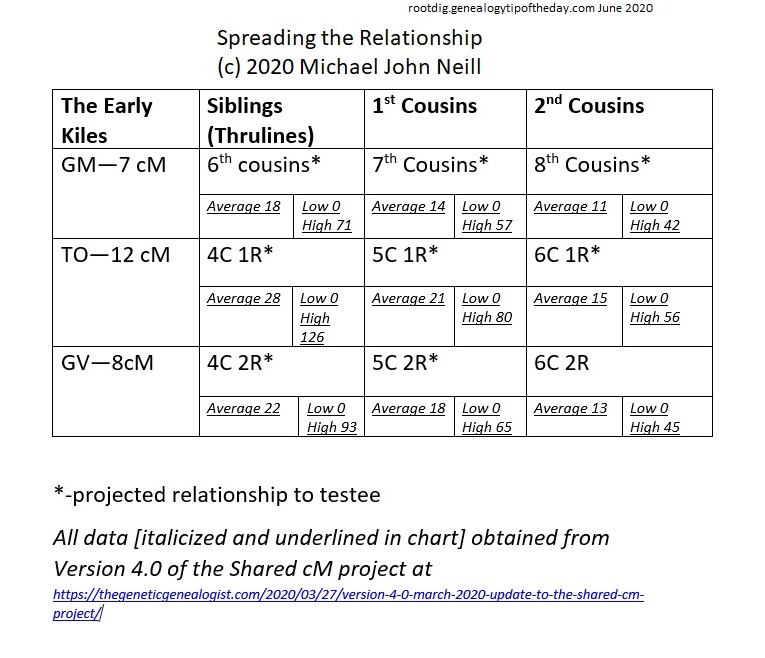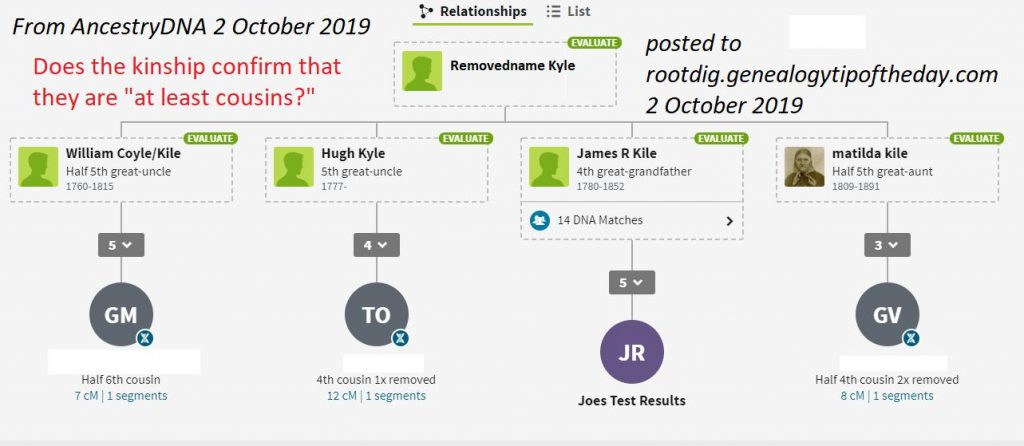This post is a followup post to “A Shared DNA & Thrulines Question” that was posted in 2019. The question asked at the end of that post was “does a shared DNA connection between the descendants of four individuals who are thought to be siblings prove that they are siblings or could they have another biological relationship?”
It’s important to remember that autosomal DNA testing is about probabilities in terms of relationships, especially when those relationships are more distant than first cousins and only a handful of individuals have tested or are matches.
What does ThruLines provide evidence of? How specific is the genealogical relationship–particularly once it starts to get more distant? I’d proffer that the shared DNA is evidence of a relationship (of course it is), but it’s not always a predictor of the specific relationship–not matter what ThruLines says. Other records need to be utilized to assist in the confirmation of the specific nature of that relationship.
Remember: ThruLines is based upon user-submitted trees which can easily contain slight errors in relationships. It may be that the “earliest group of individuals” with the same surname in an area are not siblings as some may think but instead are a group of individuals who are slightly more distantly related. The DNA may be consistent with other scenarios not produced through the ThruLines–because ThruLines is based upon compiled trees and shared DNA.
The Kiles in the illustration are thought by many researchers to be siblings. Perhaps they are and perhaps they aren’t. This post isn’t about what their relationship actually is. It’s about what the relationships could be based on the shared DNA. Note: This family is used as an illustrative example of what could be and to make the point that DNA alone does not always prove a sibling relationship–particularly at the genealogical distance in this example.

Various online trees and a few other print materials suggest that the William Kile, Hugh Kyle, James R. Kile, and Matilda Kile are siblings. ThruLines indicated that there were three matches to the DNA test I submitted that were descendants of these Kile family members.
But does the DNA evidence prove that the four Kiles are siblings? Is it possible that they are more distantly related? They would not be the first set of individuals who were thought to be siblings that were actually first cousins, two sets of siblings whose fathers were brothers, second cousins, etc. There could even be an aunt or uncle thrown in the mix–just to confuse descendants two hundred years later.
What if William, Hugh, James R., and Matilda were actually all first cousins? What if they were second cousins, how would that change the DNA shared a between the testee and these three DNA matches who also had a Kile ancestor?
The answer is not much.
It should noted that expected amount of shared DNA at this distant of a relationship can vary widely. That’s largely why the exact nature of the relationships cannot be predicted precisely.
The testee shared DNA with three other AncestryDNA testers whose trees indicated they were Kile descendants, GM, TO, and GV.
For those who are somewhat new to autosomal DNA testing, the number of shared centimorgans of DNA (cM) allows for the prediction of the likely relationship between two individuals who have submitted to a DNA test. While it’s true that one gets “one-half” of their DNA from each parent, there is no guarantee that an individual has exactly one-fourth of their DNA from each grandparent or has one-eighth of their DNA from each great-grandparent–and so on further back up the genealogical tree.
GM shared 7 cM of DNA with the testee. The ThruLines relationship was that the two were 6th cousins. Using the Shared CM Project Version 4.0, the average amount shared cM is 18 with a low of 0 and a high of 71. 7 cM is in the range, but there’s a “but.” If the earliest Kile ancestors were first cousins instead of siblings (making the testee and the match 7th cousins), the expected shared level of cM would be 14 with a low of 0 and a high of 57. If the earliest Kile ancestors were second cousins instead of siblings, the testee and the shared match would be expected to share an average of 11 cM with a low of 0 and a high of 42. Looking at the numbers, GM and the testee could easily be 6th, 7th or 8th cousins. And again, at this level, the amount of shared DNA can vary quite a bit.

The same concept applies to match TO and GV if the earliest Kile ancestor is not a sibling, but is a first cousin or a second cousin. The shared DNA is consistent with those more distant relationships.
The end result: the DNA matches to these other Kile descendants are evidence that there is probably a relationship between their Kile ancestors–but it’s not 100% solid proof that the earliest set of names as discussed earlier are siblings.
But other contemporary records are going to have to be used to determine whether the earliest Kiles are siblings, cousins, or something slightly different from that.


One response
You say in your post: “ThruLines is based upon compiled trees and shared DNA”. Amen to that. I have a number of ThruLines matches which reference a tree that might be associated to one of my paternal lines, only the DNA match itself is to my maternal side. (I’m fortunate enough to have both parents living and both parents tested.) Genealogically, that paternal line may in fact be valid but given the DNA is a match to my mom, the DNA is likely another line entirely not shown in our mutual trees.